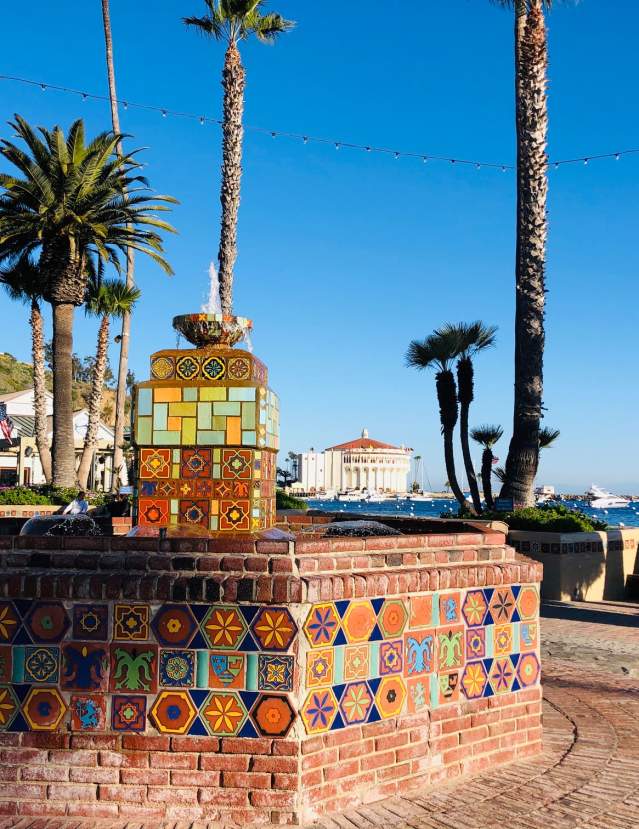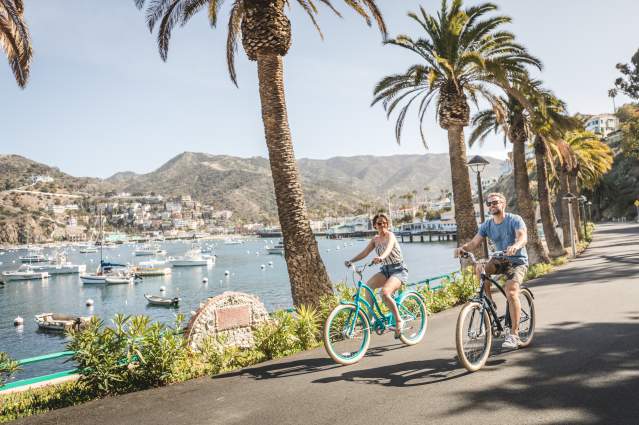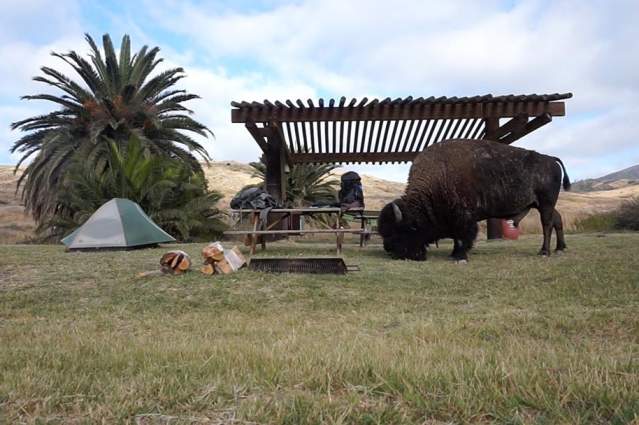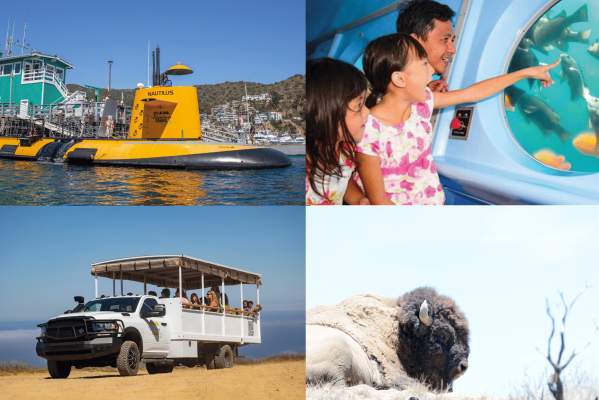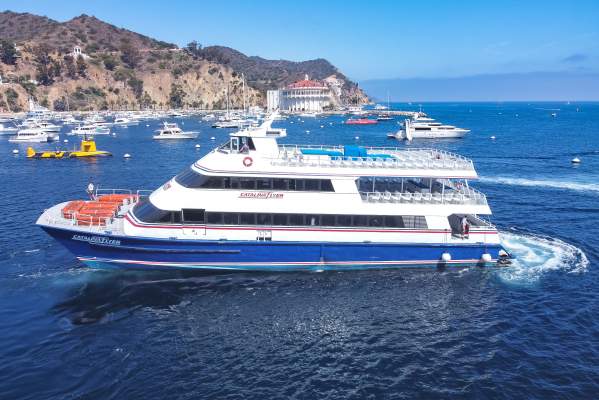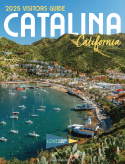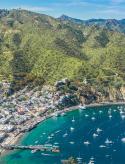Love Catalina Island Fact Sheet
Santa Catalina Island, often referred to as Catalina, is an idyllic island paradise located just off the coast of southern California. Its year-round warm weather, picturesque landscapes, outdoor activities and quaint towns make it a perfect retreat for families, adventurous couples, or solo travelers who want to escape the hustle and bustle of life on the “mainland.”
Total Area:
22 miles long, encompassing approximately 47,884 acres (76-square miles). The width is 8 miles at its widest point (Long Point) and 1/2 mile wide at its narrowest point (Two Harbors or the Isthmus). The coastal perimeter is 54 miles.
Location:
Catalina is the southernmost island of California's Channel Islands. It is situated 22 miles off the coast of southern California.
Accessibility:
Visitors can reach Catalina in about one hour by boat. Two passenger ferry companies – Catalina Express and Catalina Flyer – provide scheduled services to the island. Catalina Express operates boats to Avalon and Two Harbors daily from four mainland ports throughout the year: Long Beach, San Pedro, Dana Point and Newport Beach; Catalina Flyer operates boats to Avalon from Newport Beach seasonally.
Visitors can also arrive via helicopter or plane in about 15 minutes from the coast of southern California. Helicopter services from Maverick Helicopters are available, with departures from heliports in Long Beach and San Pedro. Helicopter charter service is also available from John Wayne Airport in Orange County, and Bob Hope Airport in Burbank. Helicopters land at the Pebbly Beach heliport located in Avalon. Private pilots can fly into the island’s only airport, Catalina Island Airport in the Sky.
Once on the island, the town of Avalon and the unincorporated village of Two Harbors are easy to navigate by foot. While ride-sharing services are not available on the island, Avalon does have a taxi service along with on demand public transit called COAST operated by Ride Circuit and transportation for visitors needing special assistance.
Catalina Towns:
The island is made up of two towns, the incorporated city of Avalon on the east end, and the unincorporated town of Two Harbors on the west end. A favorite destination for boaters, campers and adventurers, Two Harbors is 40 minutes by boat or two hours by bus from Avalon. Located directly outside of the two towns is a protected wilderness area under the stewardship of the Catalina Island Conservancy.
Population:
4,096 (based on 2010 Census data)
Climate:
Described as a mild subtropical climate, the average high temperature during the winter months is 63 degrees Fahrenheit and the average low temperature is 50 degrees. The average high temperature during the summer months hovers around 72 degrees and the average low temperature is 65 degrees. Catalina’s unique weather pattern often keeps coastal fog at bay, allowing the sun to shine an average of 267 days a year.
Dining and Shopping:
From locally caught seafood served on oceanfront patios to casual bites on the beach, Catalina has 30 different restaurants and bars to satisfy every taste and budget. Don’t miss the famous bison burgers or Catalina’s signature Buffalo Milk cocktail – a delicious concoction that includes bananas, crème de cacao, vodka and Kahlúa liqueur. The island offers both a food trail and a beverage trail in homage to the bison that were introduced to the island nearly a century ago.
Shoppers can stroll along the palm tree-lined streets of Avalon and enjoy more than 25 unique shops featuring local artisan jewelry, clothing, artwork and sweet treats. The majority of shops and boutiques are located on or adjacent to Crescent Avenue (known as “Front Street” to locals).
Accommodations:
Whether you’re looking for Spanish Colonial Revival-style hotels, historic bungalows, luxury suites, or a quaint neighborhood inn, the island has no shortage or variety of accommodations. A breakdown includes:
- 24 hotels and resorts
- 1 Bed & Breakfast Inn
- 5 vacation rental companies
The island is also home to five different campgrounds, as well as seventeen boat– in only campsites at nine locations between Avalon, Two Harbors and Parson’s Landing.
Outdoor Activities:
Catalina offers a variety of land and sea-based activities for visitors of all ages. Popular activities include:
- Biking
- Diving
- Fishing
- Golf
- Hiking
- Kayaking and paddle boarding
- Parasailing
- SCUBA diving
- Snorkeling
- Wildlife viewing
- Zip Lining
Historical Overview:
Catalina has a rich history that dates back 8,000 years ago, when the first Native Americans settled on the island. Key timelines and highlights in its history include:
- At the time of first European contact in 1542, it is thought that the Native Americans living on Santa Catalina Island called the island Pimu.
- In 1846, Catalina Island was awarded to Thomas Robbins as a Mexican land grant. Robbins established a small ranch on the Island, but sold it in 1850 to Jose Maria Covarrubias, just two years after California became a part of the United States as the result of the Treaty of Guadalupe Hidalgo.\
- By 1864, Catalina Island was entirely owned by James Lick, who was once considered the wealthiest man in California. Lick sold the island to the sons of Phineas Banning in 1891. The Banning brothers established the Santa Catalina Island Company in 1894 and began developing the island into a resort destination, building hotels, attractions, and roads into the island’s rugged interior.
- The Banning brothers built hunting lodges, like the Banning House Lodge, and ran stagecoach tours around the island. They created access to Avalon’s main beach areas, like Lovers Cove, Descanso Beach, and Sugarloaf Point, the future site of Catalina Casino. In 1909, they built the Pleasure Pier, which still stands today in Avalon Bay. In 1915, a fire burned down half of Avalon’s buildings. The brothers attempted to salvage their investment, building Hotel St. Catherine in Descanso Canyon to attract new visitors, but they eventually had to sell the island in 1919.
- In 1919, William Wrigley Jr. of Wrigley chewing gum fame bought nearly every share of the Santa Catalina Island Company from the Banning brothers. Once he owned a controlling interest, he invested millions in his vision to create a “playground for all” and develop Avalon as a resort island destination. Wrigley Jr. brought the Chicago Cubs baseball team (which he owned) to the island for spring training from 1921-1951 (with the exception of a few years during WWII).
- In the 1970’s, Phillip K. Wrigley deeded 88% of the island to the Catalina Island Conservancy so it would remain undeveloped and wild.
- The island served as a filming location for many movies in the early days of Hollywood. In fact, one of the movies filmed in the 1920s brought 14 bison to the island, where they stayed after production. Now a herd of about 150 bison roam the island’s interior.
- There are several historic landmarks that dot the towns of Avalon and Two Harbors, including the iconic Catalina Casino building. The casino was created not as a gambling facility, but as a gathering place for entertainment – playing host to dozens of Big Bands through the 1930s and 1940s.
The Catalina Island Conservancy:
Founded in 1972, the Catalina Island Conservancy is a non-profit land trust that manages and protects 88 percent of the island as a preserve. This includes more than 62 miles of unspoiled beaches and secluded coves—the longest publicly accessible stretch of undeveloped coastline in southern California. The Conservancy is a leader in programs that protect and restore endangered species and threatened habitats. It conducts educational outreach through two nature centers, its Wrigley Memorial & Botanic Garden and guided experiences in the island’s rugged interior. Access to the island’s interior is limited to permitted vehicles, bikers, hikers and authorized tour operators.
PDF Version of Love Catalina Island Fact Sheet
Executive Team Bios
Jim Luttjohann, President and Chief Executive Officer
Jim Luttjohann is the President and CEO of Love Catalina Island, the official tourism authority for Catalina Island. Since being appointed the role in 2014, Luttjohann has guided the nonprofit’s efforts to strengthen tourism and support the local economy. A strong advocate for local businesses, Luttjohann works closely with government agencies to represent the interests of community members. Prior to his role with Love Catalina Island, Luttjohann served as the Executive Director of the Santa Fe Convention and Visitors Bureau/Santa Fe Community Convention Center from 2012 to 2014, where he oversaw the Destination Marketing, Convention Center, Arts Commission, Film Office and the City's Occupancy Tax Advisory Board. From 2004 to 2012, he was the Executive Director of the Ventura Visitors & Convention Bureau where he was responsible for leading the organization through a comprehensive re-branding. During that time, he also expanded operations, including developing two new Visitors Centers and a Film Office. With more than 20 years experience in the travel and hospitality industry, Luttjohann has served as a board member of the Rotary Club of Avalon, Western Association of Convention & Visitors Bureaus, Tourism Association of New Mexico and New Mexico State Tourism's Region Five, CalTravel, Friends of the Olivas Adobe, Ventura County Lodging Alliance (T-BID), California's Central Coast Tourism Council and the Ventura Chamber of Commerce. Luttjohann holds a Bachelor’s degree in Communications and Psychology from Pepperdine University.
Cathy Miller, Vice President of Marketing and Sales
Cathy Miller is the Vice President of Marketing and Sales for Love Catalina Island, where she is responsible for the oversight of the organization’s marketing efforts and programs. Over the past four years with the organization, Miller has spearheaded initiatives to help attract visitors to Catalina Island, including developing strategic marketing and communications plans, overseeing consumer research studies and implementing consumer-facing campaigns. Prior to her role with Love Catalina Island, Miller was the Vice President of Marketing for Park City Chamber of Commerce/Convention & Visitors Bureau. During her 23-year tenure with the organization, Miller was responsible for developing and implementing annual marketing plans, and was a key player in creating the marketing campaign for the 2002 Winter Olympics hosted in Park City. Miller is a skilled grant writer who was instrumental in securing millions of dollars in grants for the Chamber, and worked with industry partners such as Utah Office of Tourism, Summit County Restaurant Tax Committee, Salt Lake City Department of Airports and Ski Utah to increase awareness about the destination. Miller holds a Bachelor’s degree in Business Administration from Northern Arizona University.
Explore the Island
Submarine & Inside Land Tours
Catalina Adventure Tours
Book Direct & Save! Tours offered multiple times daily, Submarine tours depart from Green Pier & Inside Land Tours from the Mole.
$10 Off Catalina Island Ferry
Onboard Catalina Flyer
Hop onboard the Catalina Flyer for daily ferry service from Newport Beach to Avalon, Catalina Island in just over 1 hour.
